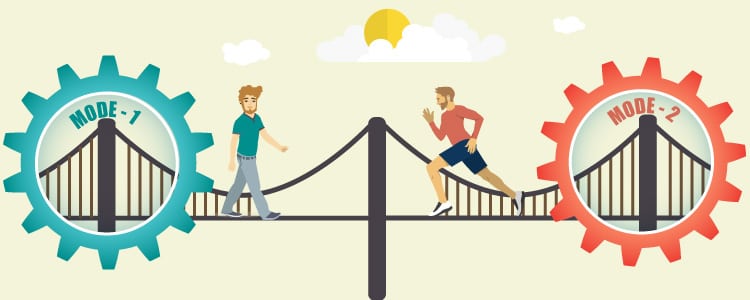
DevOps – A Bimodal Bridge in the Enterprise IT World
Where does your IT team stand on the software development map? Are you dependent on the stability and risk reduction of Mode 1, or are your teams pushing the boundaries of agile development in Mode 2?
And, is it a case of ‘never the twain shall meet?’ Not according to analysts Gartner. They forecast that by 2020 at least 80 percent of the processes identified with Mode 2 will be adopted by Mode 1 teams.
Building bridges
The bridge, they believe will be DevOps, which is currently associated with the agile techniques of Mode 2. By introducing DevOps techniques into Mode 1, businesses can have the option of a bimodal strategy using best of breed approaches for different development tasks.
Bringing DevOps into the fold doesn’t signal the end for Mode 1 development. Instead, it’s an evolution that can only improve the quality of the mission-critical applications that are characteristic of Mode 1 development.
With a bimodal approach, agile Mode 2 teams can focus on the innovative, sometimes disruptive developments that open up new product opportunities or new markets. Mode 1 teams work on the traditional enterprise applications that depend on quality, reliability and predictable performance.
Closing the culture gap
Currently, there is a big culture gap between the two types of team. Mode 2 teams use iterative processes, rapid development, continuous testing and high levels of automation to get products quickly from concept to production.
Mode 1 teams rely on traditional waterfall techniques, with separate stages and sometimes separate teams for development, testing, security, compliance and production, all with minimal automation.
DevOps plays a key role in Mode 2 development by bringing down the barriers between developers, operations and quality teams who traditionally had different goals and priorities. With DevOps the focus is on collaboration, communication and integration throughout the development cycle and, increasingly, single teams take responsibility for identifying and resolving issues during a process of continuous delivery.
Laying the foundations for DevOps
Could this approach work in Mode 1 and how would it benefit traditional processes? Commentators believe that a phased approach is essential and practical. For example, by automating certain processes, teams can speed up development and reduce the risk of problems caused by human error.
Another approach is to introduce Infrastructure as a Service (IaaS). This would enable different team members to share a consistent infrastructure and would eliminate the delays in provisioning separate physical infrastructure for different processes.
With automation and IaaS in place, Mode 1 teams can share some of the benefits enjoyed by their agile counterparts without sacrificing the essential quality and reliability.
That provides a strong foundation for introducing a wider DevOps presence into Mode 1 and helping teams meet the demand for productivity improvements and faster, more cost-efficient development.
Testing is an area where DevOps practices can help Mode 1 teams. Automating testing, together with a catalog of pre-approved changes, supports a transition to a lightweight change model.
Towards bimodal development
If businesses adopt these changes and evolve their Mode 1 processes, Gartner believes that there is a strong case for supporting a bimodal development strategy that enables businesses to make the best use of their people and their resources.
If you need support for your evolution to DevOps, Professional Service Providers like Virtual Tech Gurus are skilled at cloud infrastructure and automation techniques. They can also provide advice and guidance on the use of DevOps techniques in software development.
For more information, please check out the articles and infographics on our website.
